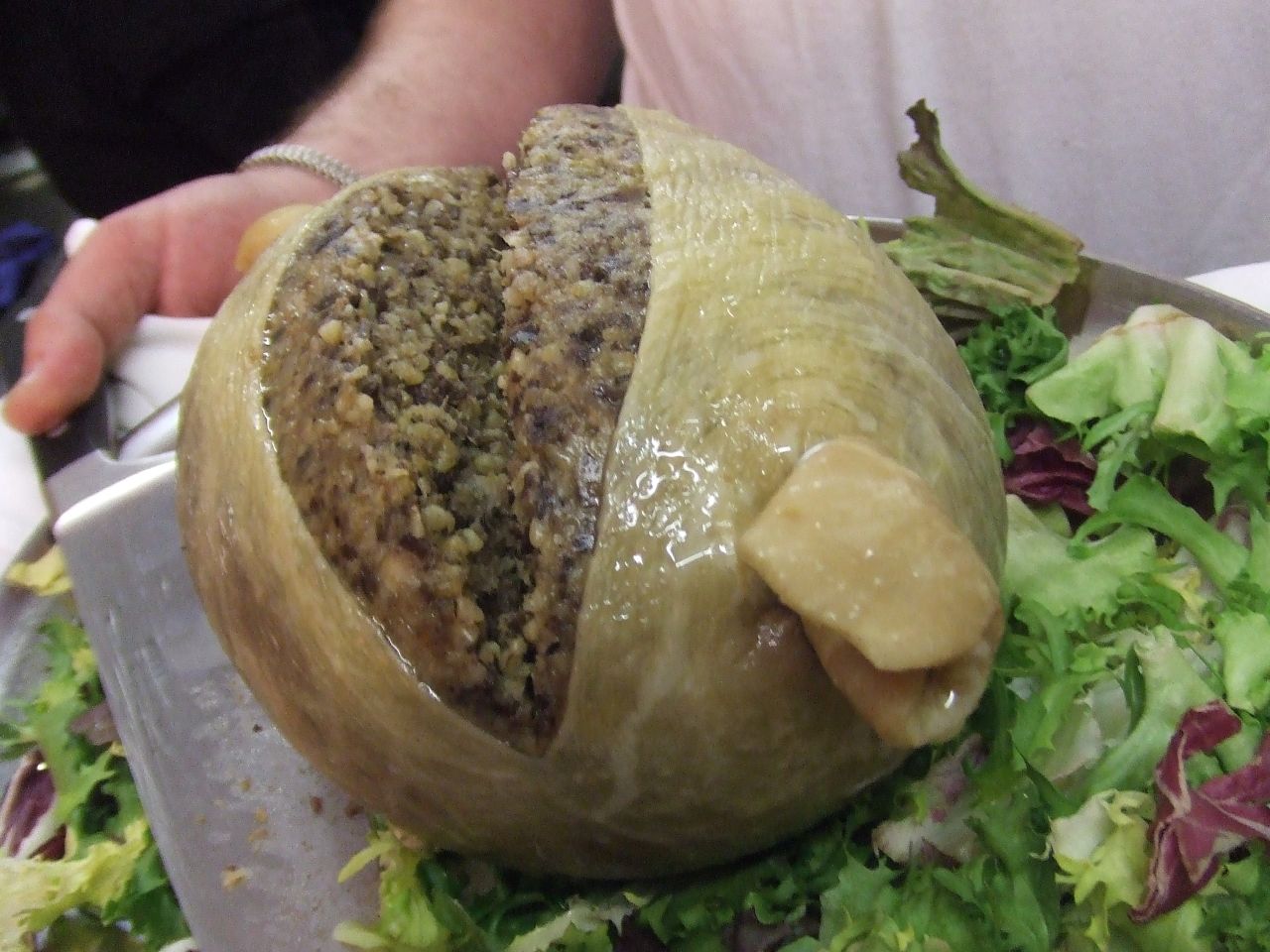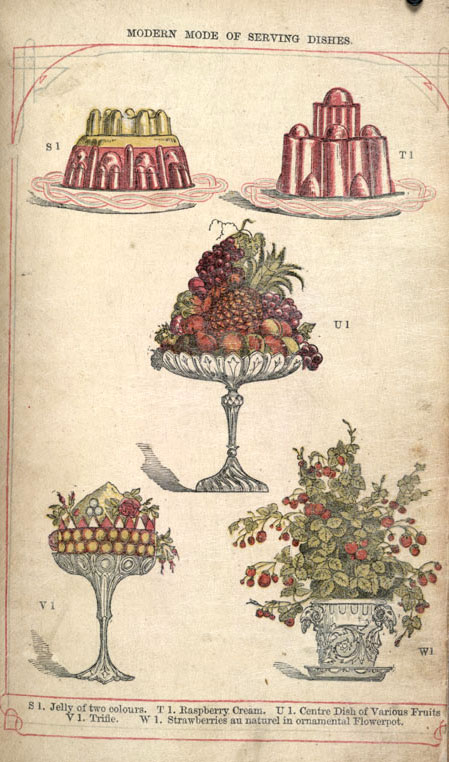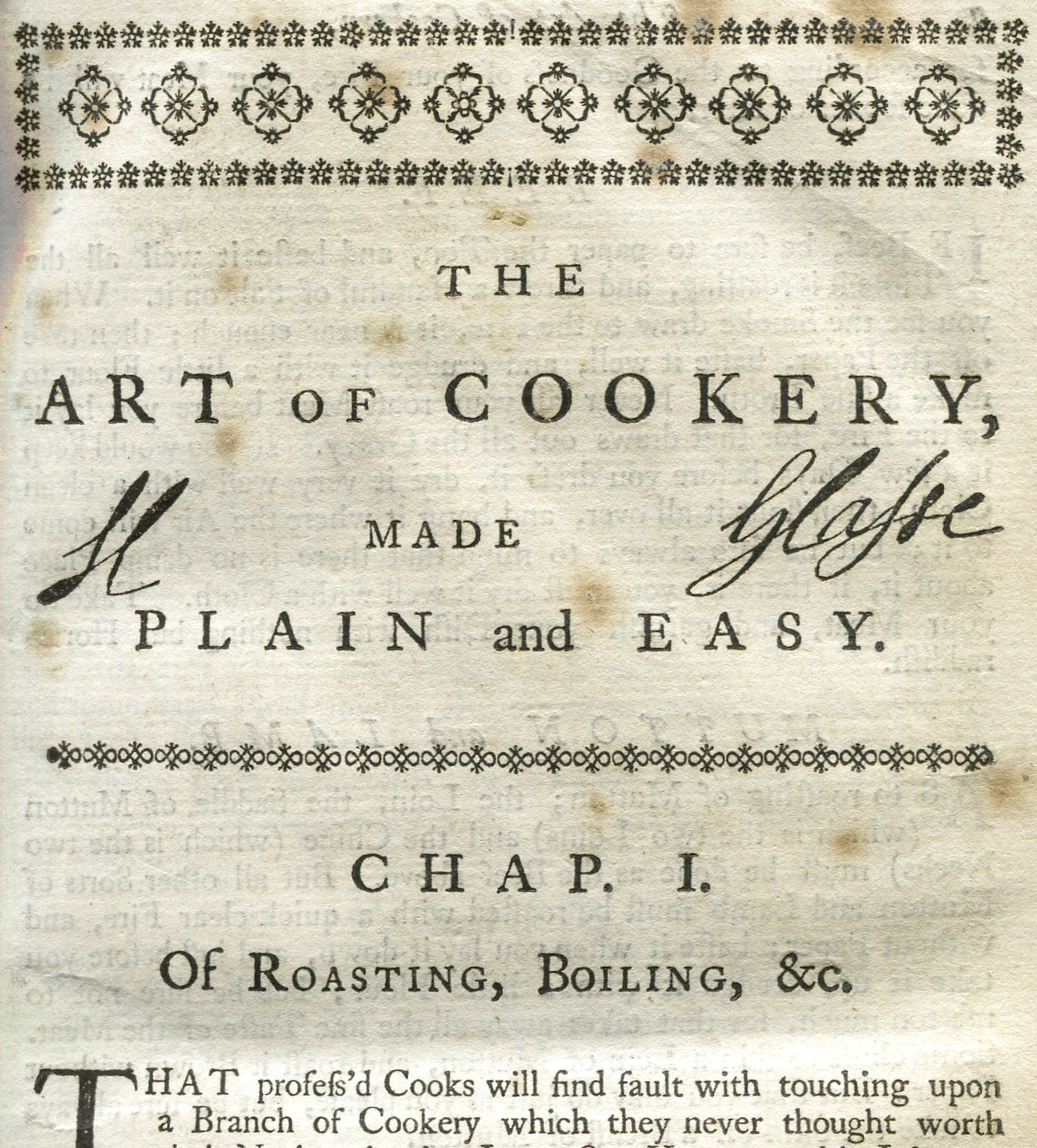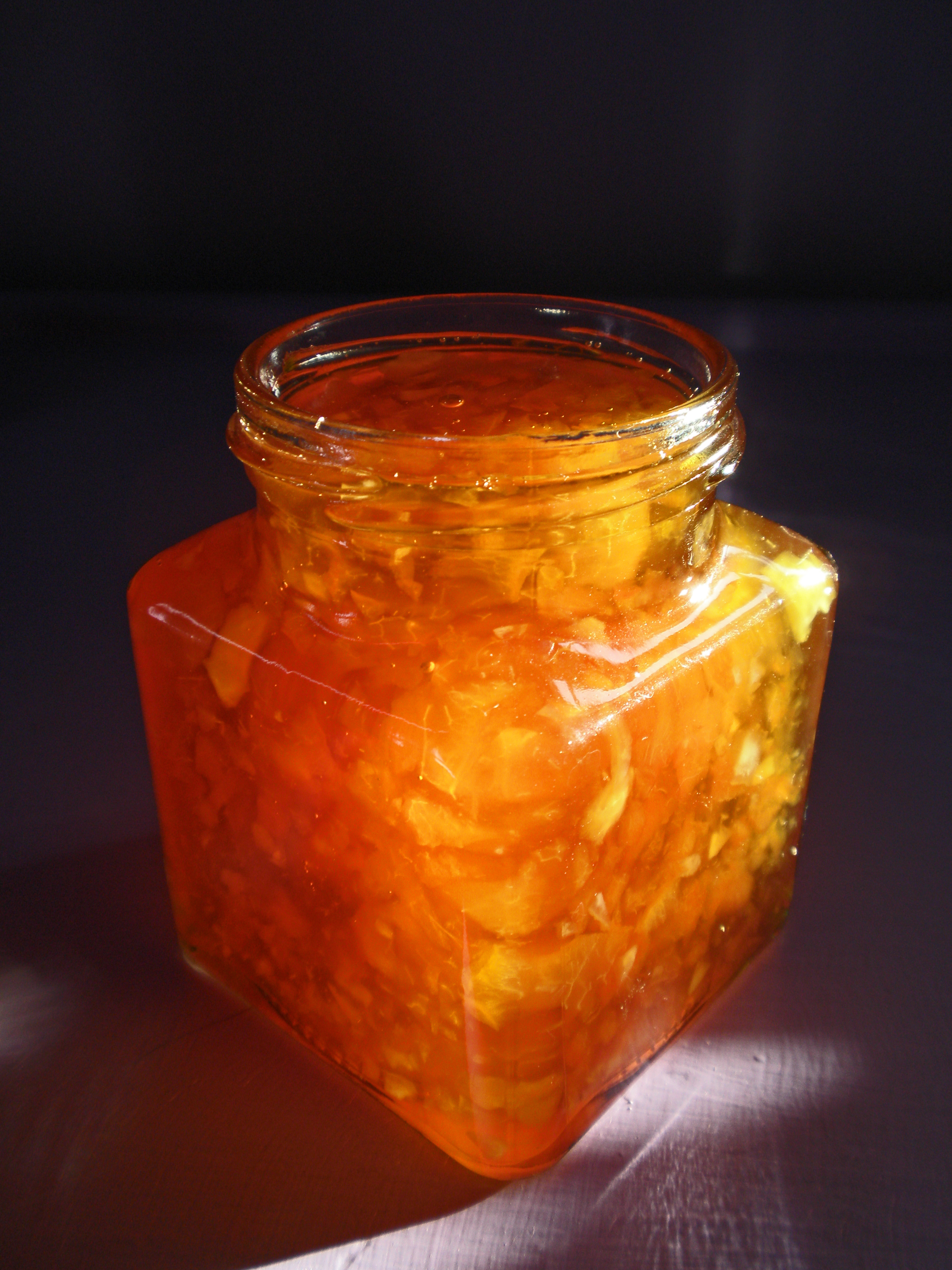|
Syllabub
Syllabub is a sweet dish made by curdling sweet cream or milk with an acid such as wine or cider. It was a popular British confection from the 16th to the 19th centuries. Early recipes for syllabub are for a drink of cider with milk. By the 17th century it had evolved into a type of dessert made with sweet white wine. More wine could be added to make a punch, but it could also be made to have a thicker consistency that could be eaten with a spoon, used as a topping for trifle, or to dip fingers of sponge cake into. The holiday punch, sweet and frothy, was often considered a ladies' drink. The milk and cream used in those days would have been thicker and modern recipes may need to make some adjustments to achieve the same effect. History Syllabub (or solybubbe, sullabub, sullibib, sullybub, sullibub; there is no certain etymology and considerable variation in spelling) has been known in England at least since John Heywood's ''Thersytes'' of about 1537: "You and I... Muste walk ... [...More Info...] [...Related Items...] OR: [Wikipedia] [Google] [Baidu] |
Pudding
Pudding is a type of food. It can be either a dessert or a savoury (salty or spicy) dish served as part of the main meal. In the United States, ''pudding'' means a sweet, milk-based dessert similar in consistency to egg-based custards, instant custards or a mousse, often commercially set using cornstarch, gelatin or similar coagulating agent such as Jell-O. The modern American meaning of pudding as dessert has evolved from the original almost exclusive use of the term to describe savoury dishes, specifically those created using a process similar to that used for sausages, in which meat and other ingredients in mostly liquid form are encased and then steamed or boiled to set the contents. In the United Kingdom and some of the Commonwealth countries, the word ''pudding'' is used to describe sweet and savoury dishes. Savoury puddings include Yorkshire pudding, black pudding, suet pudding and steak and kidney pudding. Unless qualified, however, pudding usually means desse ... [...More Info...] [...Related Items...] OR: [Wikipedia] [Google] [Baidu] |
Trifle
Trifle is a layered dessert of English origin. The usual ingredients are a thin layer of sponge fingers or sponge cake soaked in sherry or another fortified wine, a fruit element (fresh or jelly), custard and whipped cream layered in that order in a glass dish. The contents of a trifle are highly variable and many varieties exist, some forgoing fruit entirely and instead using other ingredients, such as chocolate, coffee or vanilla. The fruit and sponge layers may be suspended in fruit-flavoured jelly, and these ingredients are usually arranged to produce three or four layers. The assembled dessert can be topped with whipped cream or, more traditionally, syllabub. The name ''trifle'' was used for a dessert like a fruit fool in the sixteenth century; by the eighteenth century, Hannah Glasse records a recognisably modern trifle, with the inclusion of a gelatin jelly. History Trifle appeared in cookery books in the sixteenth century. The earliest use of the name ''trifle' ... [...More Info...] [...Related Items...] OR: [Wikipedia] [Google] [Baidu] |
Cranachan
Cranachan ( gla, Crannachan ) is a traditional Scottish dessert. It was originally a celebration of harvest, made following the raspberry harvest in June. The dessert of cream and fresh seasonal raspberries is bolstered by Scottish oats and whisky. It has been called 'the uncontested king of Scottish desserts'. Cranachan owes its origins to crowdie, a popular breakfast in which crowdie cheese is combined with lightly toasted oatmeal, cream, and local honey. Raspberries, when in season, might be added to the breakfast. Cranachan is now served all year round, and typically on special occasions. A traditional way to serve cranachan is to bring dishes of each ingredient to the table so that each person can assemble their own dessert to taste. Recipes There are many versions of this traditional Scottish pudding. Earlier recipes used crowdie cheese instead of, or in addition to cream and were sometimes called cream-crowdie. Other earlier recipes are more austere, omitting the whisky ... [...More Info...] [...Related Items...] OR: [Wikipedia] [Google] [Baidu] |
The Art Of Cookery Made Plain And Easy
''The Art of Cookery Made Plain and Easy'' is a cookbook by Hannah Glasse (1708–1770) first published in 1747. It was a bestseller for a century after its first publication, dominating the English-speaking market and making Glasse one of the most famous cookbook authors of her time. The book ran through at least 40 editions, many of which were copied without explicit author consent. It was published in Dublin from 1748, and in America from 1805. Glasse said in her note "To the Reader" that she used plain language so that servants would be able to understand it. The 1751 edition was the first book to mention trifle with jelly as an ingredient; the 1758 edition gave the first mention of " Hamburgh sausages", piccalilli, and one of the first recipes in English for an Indian-style curry. Glasse criticised French influence of British cuisine, but included dishes with French names and French influence in the book. Other recipes use imported ingredients including cocoa, cinnamon, ... [...More Info...] [...Related Items...] OR: [Wikipedia] [Google] [Baidu] |
Tom Brown At Oxford
''Tom Brown at Oxford'' is a novel by Thomas Hughes, first published in serial form in Macmillan's Magazine in 1859. It was published in two volumes in book form in 1861. It is a sequel to the better-known ''Tom Brown's School Days''. The story follows the character of Tom Brown to fictional St Ambrose's College, Oxford. The novel offers a vivid impression of university life in the mid nineteenth century. The book was out of print for many years but is available in Britain from Wordsworth Classics with 'Tom Brown's Schooldays' and is now available on the Project Gutenberg ebook site. Editions of the serialized form are available at from the Hathi Trust. The illustrator Sydney Prior Hall (1842–1922), portrait painter and illustrator, was one of the leading ''reportage Journalism is the production and distribution of reports on the interaction of events, facts, ideas, and people that are the "news of the day" and that informs society to at least some degree. The ... [...More Info...] [...Related Items...] OR: [Wikipedia] [Google] [Baidu] |
English Cuisine
English cuisine encompasses the cooking styles, traditions and recipes associated with England. It has distinctive attributes of its own, but also shares much with wider British cuisine, partly through the importation of ingredients and ideas from the Americas, China, and India during the time of the British Empire and as a result of post-war immigration. Some traditional meals, such as bread and cheese, roasted and stewed meats, meat and game pies, boiled vegetables and broths, and freshwater and saltwater fish have ancient origins. The 14th-century English cookbook, the ''Forme of Cury'', contains recipes for these, and dates from the royal court of Richard II. English cooking has been influenced by foreign ingredients and cooking styles since the Middle Ages. Curry was introduced from the Indian subcontinent and adapted to English tastes from the eighteenth century with Hannah Glasse's recipe for chicken "currey". French cuisine influenced English recipes throughout ... [...More Info...] [...Related Items...] OR: [Wikipedia] [Google] [Baidu] |
British Desserts
British may refer to: Peoples, culture, and language * British people, nationals or natives of the United Kingdom, British Overseas Territories, and Crown Dependencies. ** Britishness, the British identity and common culture * British English, the English language as spoken and written in the United Kingdom or, more broadly, throughout the British Isles * Celtic Britons, an ancient ethno-linguistic group * Brittonic languages, a branch of the Insular Celtic language family (formerly called British) ** Common Brittonic, an ancient language Other uses *''Brit(ish)'', a 2018 memoir by Afua Hirsch *People or things associated with: ** Great Britain, an island ** United Kingdom, a sovereign state ** Kingdom of Great Britain (1707–1800) ** United Kingdom of Great Britain and Ireland (1801–1922) See also * Terminology of the British Isles * Alternative names for the British * English (other) * Britannic (other) * British Isles * Brit (other) * Briton (d ... [...More Info...] [...Related Items...] OR: [Wikipedia] [Google] [Baidu] |
Posset
A posset (also historically spelled poshote, poshotte) was originally a popular British hot drink made of milk curdled with wine or ale, often spiced, which was often used as a remedy. The original drink became extinct and the name was revived in the 19th century and applied to a cream, sugar and citrus-based confection, which is consumed today as a cold set dessert nearly indistinguishable from syllabub. Introduction To make the drink, milk was heated to a boil, then mixed with wine or ale, which curdled it, and the mixture was usually spiced with nutmeg and cinnamon. It was considered a specific remedy for some minor illnesses, such as a cold, and a general remedy for others, as even today people drink hot milk to help them get to sleep. History The OED traces the word to the 15th century: various Latin vocabularies translate ''balducta'', ''bedulta'', or ''casius'' as "poshet", "poshoote", "possyt", or "possot". Russell's ''Boke of Nurture'' (c. 1460) lists various ... [...More Info...] [...Related Items...] OR: [Wikipedia] [Google] [Baidu] |
Bitter Orange
Bitter orange, Seville orange, bigarade orange, or marmalade orange is the citrus tree ''Citrus'' × ''aurantium'' and its fruit. It is native to Southeast Asia and has been spread by humans to many parts of the world. It is probably a cross between the pomelo, ''Citrus maxima'', and the mandarin orange, ''Citrus reticulata''. History Wild trees are found near small streams in generally secluded and wooded parts of Florida and the Bahamas after it was introduced to the area from Spain, where it had been introduced and cultivated heavily beginning in the 10th century by the Moors. Identification Citrus × aurantium can be identified through its orange fruit with a distinctly bitter or sour taste. The tree has alternate simple leaves and thorns on its petiole. Usage Many varieties of bitter orange are used for their essential oil, and are found in perfume, used as a flavoring or as a solvent, and also for consumption. The Seville orange variety is used in the production of marma ... [...More Info...] [...Related Items...] OR: [Wikipedia] [Google] [Baidu] |
Sack (wine)
Sack is an antiquated wine term referring to white fortified wine imported from mainland Spain or the Canary Islands.Oxford Companion to Wine: Sack There was sack of different origins such as: * Canary sack from the Canary Islands, * Malaga sack from , * Palm sack from , and * Sherris sack from The term ''Sherris sack'' later gave way to |
Hannah Glasse
Hannah Glasse (; March 1708 – 1 September 1770) was an English cookery writer of the 18th century. Her first cookery book, ''The Art of Cookery Made Plain and Easy'', published in 1747, became the best-selling recipe book that century. It was reprinted within its first year of publication, appeared in 20 editions in the 18th century, and continued to be published until well into the 19th century. She later wrote ''The Servants' Directory'' (1760) and ''The Compleat Confectioner'', which was probably published in 1760; neither book was as commercially successful as her first. Glasse was born in London to a Northumberland landowner and his mistress. After the relationship ended, Glasse was brought up in her father's family. When she was 16 she eloped with a 30-year-old Irish subaltern then on half-pay and lived in Essex, working on the estate of the Earls of Donegall. The couple struggled financially and, with the aim of raising money, Glasse wrote ''The Art of Cookery''. She ... [...More Info...] [...Related Items...] OR: [Wikipedia] [Google] [Baidu] |
Diary Of Samuel Pepys
Samuel Pepys (; 23 February 1633 – 26 May 1703) was an English diarist and naval administrator. He served as administrator of the Royal Navy and Member of Parliament and is most famous for the diary he kept for a decade. Pepys had no maritime experience, but he rose to be the Chief Secretary to the Admiralty under both King Charles II and King James II through patronage, diligence, and his talent for administration. His influence and reforms at the Admiralty were important in the early professionalisation of the Royal Navy. The detailed private diary that Pepys kept from 1660 until 1669 was first published in the 19th century and is one of the most important primary sources for the English Restoration period. It provides a combination of personal revelation and eyewitness accounts of great events, such as the Great Plague of London, the Second Dutch War, and the Great Fire of London. Early life Pepys was born in Salisbury Court, Fleet Street, London, on 23 Februar ... [...More Info...] [...Related Items...] OR: [Wikipedia] [Google] [Baidu] |




.jpg)


